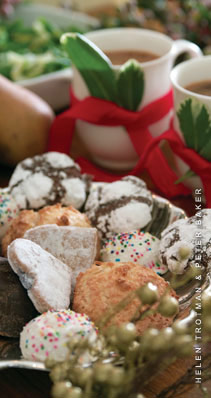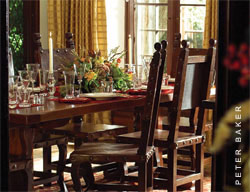Timeless Holiday Celebrations
Local residents share their treasured holiday traditions
Jim Montalto writer
As the holidays rush upon us, it can be easy to become overwhelmed by the crowds of manic shoppers that seem to increase at every turn or by children riddled with an over- excited energy from the anticipation of good times to come. Perhaps that’s why we have holiday traditions; those time-honored practices that are passed down from generation to generation and performed the same way, the same time every year. They help slow us down, focus, and remind us of the true meaning and spirit behind the holidays, whether it’s Christmas, Hanukkah, Ramadan or any other special celebration that lasts into winter’s early days.
excited energy from the anticipation of good times to come. Perhaps that’s why we have holiday traditions; those time-honored practices that are passed down from generation to generation and performed the same way, the same time every year. They help slow us down, focus, and remind us of the true meaning and spirit behind the holidays, whether it’s Christmas, Hanukkah, Ramadan or any other special celebration that lasts into winter’s early days.
Traditions don’t have to be elaborate, complicated affairs. They can be simple parties, community gatherings or quiet events that create special moments during a hectic time.
“Our approach to the holidays is laid back and un-fussy,” says Deb Nicoletti, who co-owns Pettinelli & Bean, a tabletop design company, with her twin sister, Marcy Morse. Getting to that point, the twins admit, is all about knowing your strengths and limitations. For meals, consider preparing food you’ve made before and avoid experimenting with new dishes on the day of the big party. Better yet, think of something you can cook the night prior to the celebration.
“Cook what you know. I’ve always loved the idea of a special breakfast on Christmas morning,” says Nicoletti, her eyes widening as she reminisces about an old raised-dough recipe and other meals that have filled her family’s kitchen with wonderful aromas during the holidays.
“We’ve always cooked a quiche-type dish mixed with ham and eggs on Christmas Eve. It’s something you can pop in the oven in the morning when everyone is opening presents and it makes the house smell wonderful,” she says.
“Fresh cinnamon rolls smell great too,” adds Morse.
For Morse and Nicoletti, the holiday experience goes beyond the food; they’ve always liked to surprise their kids with festive table settings.
“Put out brightly colored and fun placemats, napkins, and tableware. Spread around the table fresh-cut greens like bayberry and holly, or any green you might be able to find in your own backyard,” Nicoletti suggests.
Morse adds unscented candles, like votives, to her table top, too, but suggests having them in any room for a festive ambience that isn’t too fussy and won’t take too much time to create.
Marbo Hansen, founder of the event design, planning, and
management company Vivant, took Morse and Nicoletti’s decorative tabletop idea a step further.
“After the holidays a few years ago, we bought inexpensive holiday plates. At the next holiday dinner, each family member wrote a little memory on their plate. This year the plates will be passed out to a different family member, and they too will add their memories to the plates.”
As the years go by, her family can reflect on how this tradition was started together, and the children will have a family heirloom they can call their own. Hansen recalls finding frugal ways to decorate the Christmas tree when she and her husband were just married and how that has grown into the tradition it is today.
“Our first years together I made felt ornaments,” she says. “The one that’s lasted is the brown-eyed, brown hair felt angel that is almost 30-years old. Every year my children insist on putting it at the tree top,” she laughs.
Eventually the felt ornaments, except for the angel, were replaced with ornaments that represented a special memory of their children’s lives.
“This has really made the holiday special for us,” says Hansen. “Sometimes the process of getting the tree and decorating it can be a real drag. Giving our children an individual ornament that represents something meaningful in their lives, whether it was the time they began music lessons, or soccer, or had their first boyfriend, is a wonderful way to commemorate their life.”
It is this same sense of connection, but on a broader scale, that Eileen Morris tries to instill in the youth with whom she works as Acting Associate Minister of Wellesley Hills Congregational Church.
 “When the holidays come we do something for us and, more importantly, something for our community,” says Morris.
“When the holidays come we do something for us and, more importantly, something for our community,” says Morris.
Each year, about 120 kids in grades 6 to 12 gather for dinner, games and the traditional New England Yankee swap. Everyone brings a small gift and each child takes a turn choosing between an unopened gift and one that’s already been opened before their turn.
Each year the church youth also focus on filling the needs of those less fortunate. Last year, they gathered toiletries and about 180 pairs of socks for Boston’s St. Francis shelter. She says this year, in addition to helping the homeless, the kids will help Hurricane Katrina victims by sending them water bottles, back packs and gift certificates.
“The understanding the kids have about the number of people that need help, and that they can do something about it is quite amazing. But that’s what the holidays should be about, understanding how to live your faith by giving to others.”
Providing for those less fortunate plays a big role in the Raab family’s Hanukkah celebration. Wellesley psychologist Ingrid Raab says that for her family, Hanukkah is much more than giving gifts and, in fact, contributing to worthy causes is very much a part of this Jewish tradition. Each year, the Raab family decides together which organizations they wish to support and write checks as part of the holiday ritual. When asked how her family spends each evening, Raab replied that because Hanukkah lasts for eight nights, children’s homework and obligations often get in the way of elaborate dinners and celebrations every night.
The first night of Hanukkah, however, is always special and commemorated by crowd-pleasing latkes. Latkes are similar to potato pancakes, except matzo meal is used instead of flour, and they are usually accompanied by sour cream and applesauce. Raab also makes them with beets, carrots and celery. The latkes are fried in oil which is symbolic of the oil burned in the original menorahs which play a significant role in this “Festival of Lights.” Preparation of latkes can be somewhat labor intensive, especially since Raab grates the potatoes by hand. She doesn’t seem to mind the extra effort though, and adds that sometimes the children will pitch in and help.
Traditional foods play a big role in the celebration of the end of the Muslim holiday Ramadan as well, but Wellesley dentists Drs. Ejaz and Femina Ali, are quick to point out that their tradition is also very much about helping others. “After a month of fasting from dawn to sunset, a big part of the celebration is about the food, that’s true,” Dr. Ejaz says, “but the important part for all of us is about being with our families and coming together as a community to see what we can do to help those in need.”
Most of the month-long holiday, which usually occurs between early fall and early winter, is a quiet time for prayer and reflection. The last Friday of Ramadan, though, is a time for the ladies and children to party. They dress in sarees, colorful gowns covered with embroidery and glitter, and glass bracelets adorn their arms. They take turns decorating each other’s hands and arms with henna, temporary tattoo flower and paisley designs created from a colored paste.
“The women have a great time dancing and singing. The children get presents and usually money too. The men, they sit around and complain,” laughs Dr. Femina.
On Eid, the end of Ramadan, families gather at each other’s homes after morning prayers. They enjoy an assortment of family recipes from fresh bread and samosas (triangular pastries stuffed with meat and vegetables) to rice pudding and Chat, a spicy fruit salad.
The tradition, Zakat, also occurs this time of year when Muslims give a percentage of their money to those in need. Dr. Ejaz says Zakat is an opportunity to help anyone in the community, from families struggling to survive to people who may have just moved to the area.
Welcoming newcomers is one of Dira Cannistraro’s specialties. As corresponding secretary of the Newcom-ers’ Club of Wellesley, she manages the traditional cookie exchange program.
“The cookie exchange has been going on since the club started in 1959,” she explains. “It can be overwhelming to move somewhere new, so our holiday party helps families feel at home and become connected to others.”
About 25 women gather and exchange holiday cookie recipes. Some they’ve invented, while others have been passed down to them through the generations.
Hansen says the success of holiday celebrations depends on knowing your audience and planning ahead. If your guest list includes adults and children, consider an activity for the kids so the adults can mingle. A pre-made mix can quickly provide baked cookies that kids can frost or decorate.
Nicoletti and Morse agree. “Do anything that can make your life easier this time of year. Don’t plan something so difficult that you can’t enjoy time with family and friends, because that’s what it’s all about.”
After all, traditions were meant to create family and community togetherness. As new ones emerge and old ones are shared, they become unique and truly special celebrations that all can appreciate and enjoy.
© 2006 Elm Bank Media



recent comments